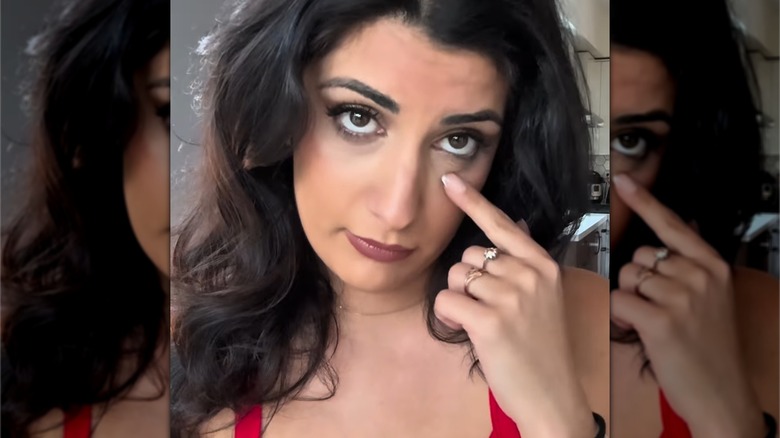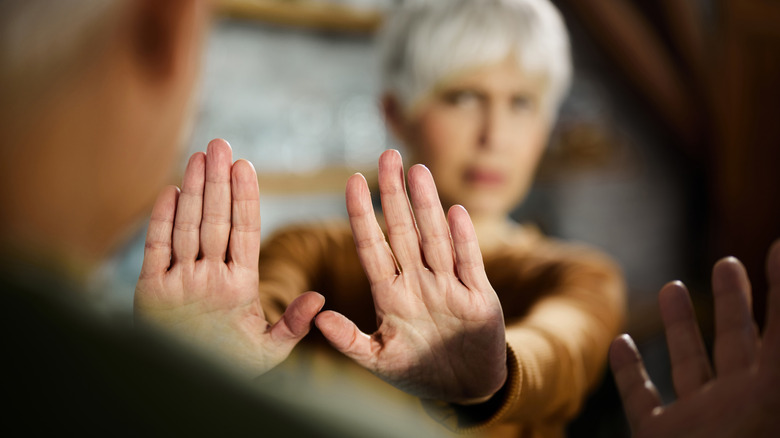Rick Steves Recommends Learning These Crucial European Gestures Before Your Trip
When we communicate with each other, we do it with more than just our voices. Just try putting your hands behind your back while having a conversation and see how difficult it can be to be completely understood. While Italians are most well known for talking with their hands, we all do it. Consider how many times you've given someone the thumbs up to signal approval, thrown your palms up in the air to express frustration, or used a certain finger to let the person who cut you off in traffic know exactly how you feel about it. There are lots of gestures we take for granted in the U.S. because we assume people will know what we mean. However, if you visit Europe, there can be a communication breakdown without even saying a word. Travel pro Rick Steves has some great tips on gestures to try out and ones to avoid on his website. He explains, "In Europe, while some gestures can help you communicate, others can contribute to the language barrier."
Misunderstandings can happen even when you speak the same language. For instance, Steves says that the "V" for victory/peace sign where you hold your index and middle finger in a "V" position might not be a big thing in America, no matter how you do it. However, in the U.K., if your palm is facing toward you, it's a rude gesture. In fact, there is even a scene in the 2017 film "Darkest Hour" where Prime Minister Winston Churchill (Gary Oldman) does it the wrong way and gets a lesson in what it means.
Nods, eyes, and nose gestures to be wary of in Europe
One gesture that may seem like it would be universal is the nod of agreement. You probably don't even realize you're doing it if you're also saying "yes" or "I understand." However, in Bulgaria, a nod means no and a shake from side to side is yes. In Türkiye or Greece, you can shake your head for no, but you also may toss your chin up a bit (in a half-nod) with a "tsk" sound. (Oddly enough, the word for yes in Greek is nαί, pronounced "nay," which can mean no in English.) This one is pretty important to know before you go.
One gesture you might not recognize but should keep in mind is the eyelid pull. Rick Steves says that in France and Greece, putting your pointer finger under the center of your eye and pulling the skin down means "I know what you're doing" or "be careful." In Italy and Spain, however, they may be warning you that someone else you're speaking to is clever and to keep your wits about you.
You may be familiar with the gesture when you lay a finger on the side of your nose (à la Santa Claus in "Twas the Night Before Christmas"), but you may not know what it means. In Europe (and sometimes in America), making this gesture or tapping the side of your nose means that something is to be kept secret or confidential. (Similar to how, in the U.S., we tend to use a finger in front of our mouths, making a "shh" noise.) However, in Italy, touching the side of your nose is considered a warning sign.
Gestures with the lower face to watch out for in Europe
If you've been on social media at all in recent years, you probably know the gesture that we Americans call the "chef's kiss." Kissing your finger tips and lifting the closed fingers into the air is a gesture in Italy, France, Spain, Greece, and Germany to mean something is good or delicious, according to Rick Steves. One gesture you may not be that familiar with, however, is the cheek screw. While you might put your index finger on the side of your cheek to denote something twee or overly cutesy, in Italy, it means that something is really delicious or that someone is clever. There, you also twist the finger into the cheek. Be wary of using this one in Spain, however, because the cheek screw means you're inferring that a man is effeminate.
One gesture you really don't want to use unless necessary is the chin flick. You throw your head back a bit and flick the back of your fingers under the chin and toward the person you're speaking to. In Italy and France that means you're definitely not interested, and in southern Italy specifically, it's a firm "no," and one that is meant to be insulting.
Gestures with the hands and arms in Europe
Your hand and arm gestures can also have alternate meanings in Europe. In Greece, avoid the common hand gesture where you put your palm facing forward. While in the U.S. it means "stop" or "hello," in Greece it's called the "moutza," and it is considered really offensive. Another one to avoid that you may not use in the U.S. is the forearm jerk. Rick Steves explains that you "Clench your right fist and jerk your forearm up as you slap your right bicep with your left palm." This is a rude and phallic gesture in Southern Europe (though it might be used to say someone is hot in the U.K. and Germany). Meanwhile, if you're shopping and you see someone shake their hand and suck in their breath in Europe, this is a gesture that means something is expensive.
You should avoid the okay sign with the pointer finger and thumb in a circle with the rest of the fingers up. It can have negative connotations in the U.S. these days, and it's considered an insult in Greece, Italy, and Türkiye. If you make a little purse with your hand with the fingers facing up, that can mean "what's up" or "what are you doing" in Italy, but it's not the most polite. Steves says it can also mean "fear" in France, "a lot" in Spain, or "good" in Greece and Türkiye. Another gesture to avoid is the devil horns, which may mean "rock out" in the United States, but symbolizes that someone is being cheated on in Italy, Portugal, and Spain. Finally, if you want a fun way to communicate with the locals in Italy and put this all into practice, Steves recommends the evening passeggiata where people come to the main square to catch up and see and be seen.



